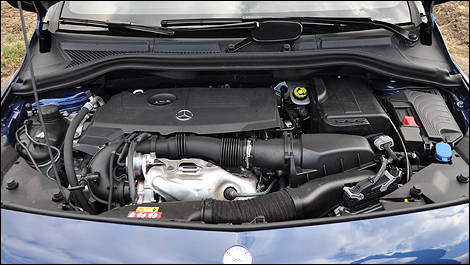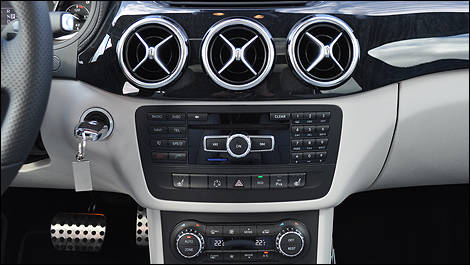Now, unfortunately, I cannot tell you which engine we'll be getting in our new B-Class come next year. However, what I can state for certain is that it will not be any of those made available to us on our drive day. My partner and I selected the B 200 BlueEFFICIENCY which sports a turbocharged 1.6L 4-cylinder. In the “200” state of tune, it produces 156 hp and 184 lb.-ft of torque. A B 180 is also at European buyers' disposals and it develops 122 hp.
I picked the BlueEFFICIENCY powerplant out of the lot (two CDI diesels were also on hand) because it best represents the power expectations the North American market has of a premium product such as the Mercedes B-Class. With plenty of grunt, the 1.6T managed the B's svelte-ish 1,400kg beautifully.
Mercedes tells us that we Canucks, and other markets in the world, will get another all-new motor that will be related to the 1.6L, and it'll be one that is not yet offered in any other Mercedes product. I suspect that a 2.0L (more than likely turbocharged) will make a return, and its output figures will reflect those currently available in the 2011 B-Class with a few extra ponies (I guesstimate at 160 and 220 hp), but will be considerably better on fuel and far more refined.
On that subject, I can announce to you that the 5- or 6-speed manual gearboxes are no more in the 2013 B-Class. All of our cars will be activated by a 7-speed, dual-clutch transmission known as the 7G-DCT. My buddy and I managed to drive two models with the same 'box, and I was quite pleased with its performance.
In “D,” shifts are smooth and without shock. In Sport mode, throttle and gear-change management sharpens slightly; however, it's only in “M” or manual mode that the nature of the 'box appears. More often than not, it would delay downshifts in spirited driving – its self-preservation programming quickly became obvious.
The existence of the DCT brings with it a near 10% improvement in fuel economy over the previous CVT. A good portion of those savings are attributable to the standard ECO Start/Stop function which can be activated by depressing the ECO button in the centre console. Unlike other rare cars equipped with this green feature, the Start/Stop in the B-Class would repeatedly shut on and off at the slightest pedal input. In Vienna traffic, stranded in a saturated intersection, the function easily cycled a dozen times in a two-minute window.
What always meshes well with a winning exterior design and some positively good driving dynamics is a smart cockpit. With the new 2013 B-Class, Mercedes has insured that nothing was left to chance. Borrowing from the corporate parts bin, the B-Class' dash incorporates high-quality materials, straightforward switchgear and the type of craftsmanship we've come to expect from Stuttgart.
 |
| My partner and I selected the B 200 BlueEFFICIENCY which sports a turbocharged 1.6L 4-cylinder. (Photo: Mathieu St-Pierre/Auto123.com) |
I picked the BlueEFFICIENCY powerplant out of the lot (two CDI diesels were also on hand) because it best represents the power expectations the North American market has of a premium product such as the Mercedes B-Class. With plenty of grunt, the 1.6T managed the B's svelte-ish 1,400kg beautifully.
Mercedes tells us that we Canucks, and other markets in the world, will get another all-new motor that will be related to the 1.6L, and it'll be one that is not yet offered in any other Mercedes product. I suspect that a 2.0L (more than likely turbocharged) will make a return, and its output figures will reflect those currently available in the 2011 B-Class with a few extra ponies (I guesstimate at 160 and 220 hp), but will be considerably better on fuel and far more refined.
On that subject, I can announce to you that the 5- or 6-speed manual gearboxes are no more in the 2013 B-Class. All of our cars will be activated by a 7-speed, dual-clutch transmission known as the 7G-DCT. My buddy and I managed to drive two models with the same 'box, and I was quite pleased with its performance.
In “D,” shifts are smooth and without shock. In Sport mode, throttle and gear-change management sharpens slightly; however, it's only in “M” or manual mode that the nature of the 'box appears. More often than not, it would delay downshifts in spirited driving – its self-preservation programming quickly became obvious.
The existence of the DCT brings with it a near 10% improvement in fuel economy over the previous CVT. A good portion of those savings are attributable to the standard ECO Start/Stop function which can be activated by depressing the ECO button in the centre console. Unlike other rare cars equipped with this green feature, the Start/Stop in the B-Class would repeatedly shut on and off at the slightest pedal input. In Vienna traffic, stranded in a saturated intersection, the function easily cycled a dozen times in a two-minute window.
What always meshes well with a winning exterior design and some positively good driving dynamics is a smart cockpit. With the new 2013 B-Class, Mercedes has insured that nothing was left to chance. Borrowing from the corporate parts bin, the B-Class' dash incorporates high-quality materials, straightforward switchgear and the type of craftsmanship we've come to expect from Stuttgart.
 |
| Improvement in fuel economy are attributable to the standard ECO Start/Stop function which can be activated by depressing the ECO button in the centre console. (Photo: Mathieu St-Pierre/Auto123.com) |


